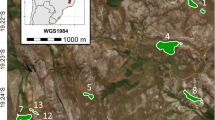Abstract
Ant mosaics have been described as characteristic elements of arboreal ant communities from tropical plantations, and it is often assumed that they also exist in undisturbed lowland rain forests. Until now, however, there have been no studies from pristine rain forests to show this. Our investigations on the mechanisms structuring arboreal arthropod communities in a southeast-Asian lowland rain forest allowed us to compare our results with the predictions of the ant mosaic theory. According to this theory aggressive dominant ant species should maintain mutually exclusive territories. Furthermore, communities of associated nesting species dominated by the same dominant species should be more similar to each other than communities governed by other dominants. The ant communities of 19 individuals of three understorey tree species were collected with an improved method of canopy fogging that guaranteed selective tree sampling in a multilayered rain forest. Ten trees were re-fogged after 6 months and seven again after 3 years to investigate whether the reorganization of the ant communities occurred in a similar way. To test whether the pattern of an ant mosaic emerged when not only single trees but also somewhat larger areas containing several adjacent trees were sampled, we collected the nesting ant species from a group of Aporusa lagenocarpa with tuna baits. All ant communities were highly heterogeneous in their species composition and neither negative nor positive species associations were found. The lack of an ant mosaic in mature forests is also suggested by a Monte Carlo computer simulation, according to which ant community composition differed only slightly from random. The re-fogged communities showed the same structural heterogeneity as was found in the first fogged communities, without any observable convergence to the original species composition. No pioneer or climax species could be identified. All results combined indicate that the ant mosaic theory does not apply to the mature lowland rain forest investigated, where community organization seems to be the product of very complex dynamic processes.
Similar content being viewed by others
Author information
Authors and Affiliations
Additional information
Received: 19 August 1999 / Accepted: 15 November 1999
Rights and permissions
About this article
Cite this article
Floren, A., Linsenmair, K. Do ant mosaics exist in pristine lowland rain forests?. Oecologia 123, 129–137 (2000). https://doi.org/10.1007/s004420050998
Issue Date:
DOI: https://doi.org/10.1007/s004420050998




